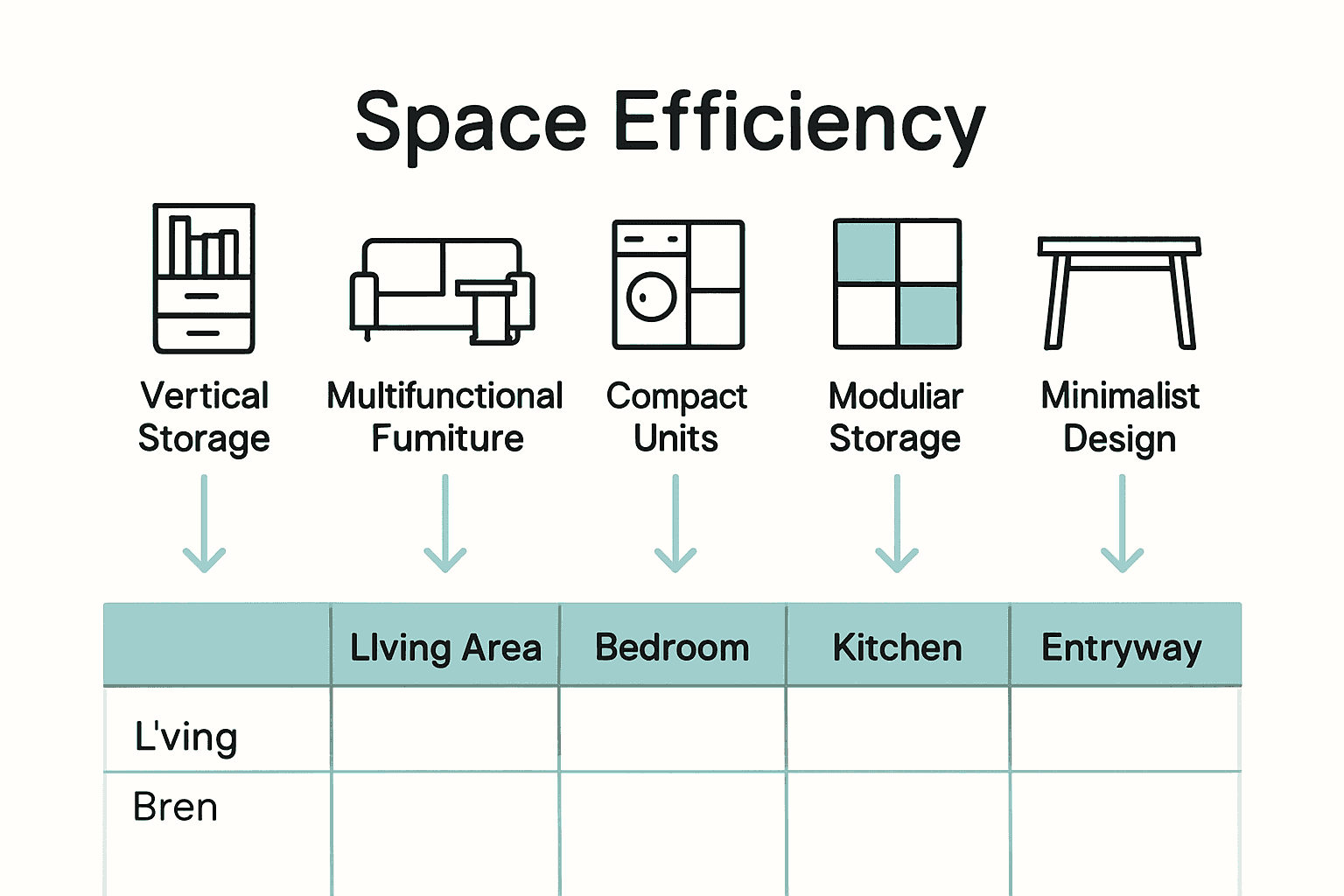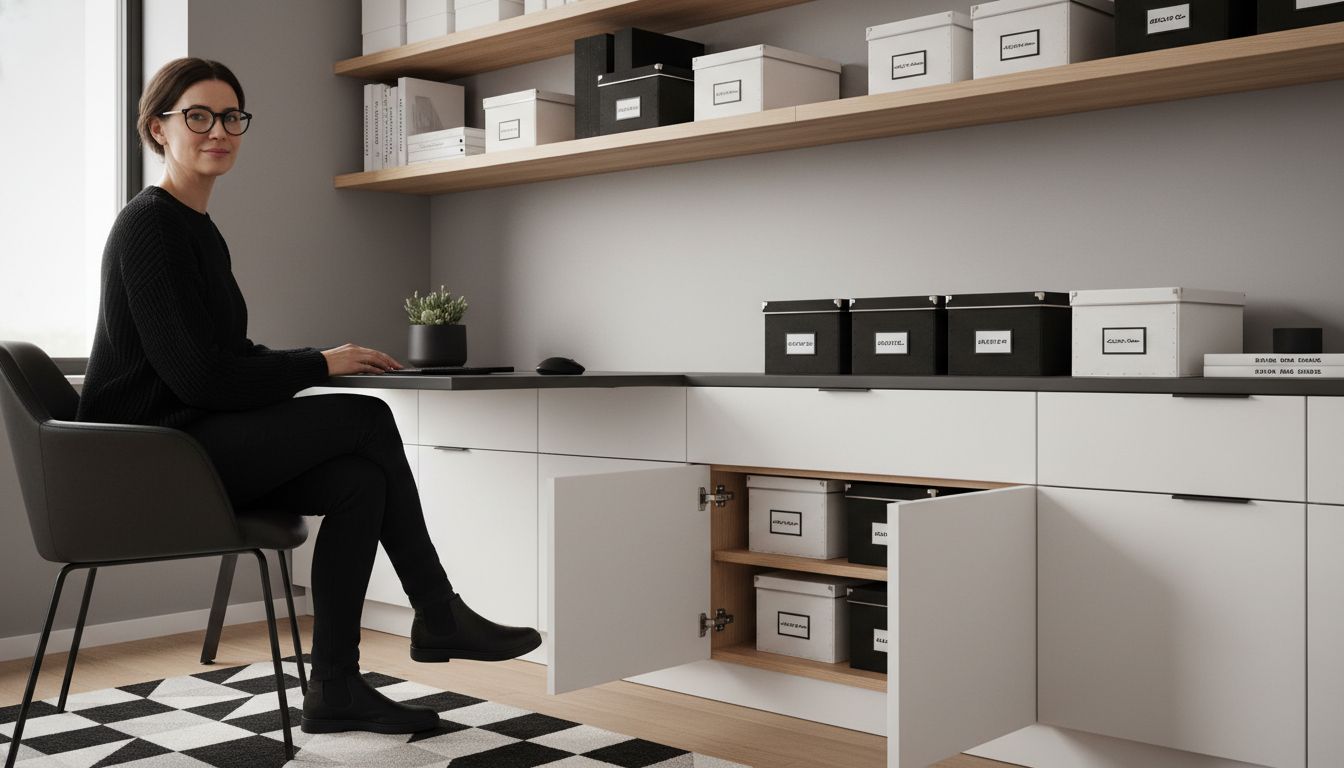
Did you know that optimizing your living space can improve comfort and even lower energy bills? As people shift toward smaller homes and greener lifestyles, space efficiency becomes more valuable than ever. Nearly 80 percent of homeowners report feeling less stressed in organized, efficient rooms. Simple changes in layout, storage, and furniture can transform crowded spaces into cozy, functional environments tailored to your needs.
Table of Contents
- Defining Space Efficiency And Core Concepts
- Types Of Space Efficiency In Homes
- Key Principles For Maximizing Space
- Practical Strategies For Space-Saving Organization
- Common Mistakes And How To Avoid Them
Key Takeaways
| Point | Details |
|---|---|
| Space Efficiency | Maximize functionality and minimize wasted space through intelligent design and innovative storage solutions. |
| Utilization Strategies | Employ vertical storage, multifunctional furniture, and minimalist designs to expand usable space and enhance organization. |
| Lighting and Color | Use light, neutral palettes and strategic lighting to create the illusion of openness in compact environments. |
| Common Mistakes | Avoid oversized furniture and underutilization of vertical space to improve overall spatial efficiency and adaptability. |
Defining Space Efficiency and Core Concepts
Space efficiency is the strategic art of maximizing functional utility within a given physical area while minimizing wasted space. According to avanti publishers, space efficiency involves “optimal use of available space within a building to maximize functionality and minimize waste.”
At its core, space efficiency goes beyond simple organization. It’s about creating intelligent design solutions that transform limited square footage into versatile, purposeful environments. This approach requires thoughtful planning, innovative storage strategies, and a keen understanding of how spatial arrangements impact daily living. The goal isn’t just to fit more items into a space, but to enhance the overall usability and comfort of that area.
In the context of modern living, space efficiency has profound implications. Green home research highlights that efficient spaces aren’t just about physical arrangement, but also about sustainability. Efficient design can reduce energy consumption, minimize material waste, and create environmentally conscious living environments that maximize functionality within a minimal footprint.
Key characteristics of space-efficient design include:
- Multifunctional furniture and storage solutions
- Vertical space utilization
- Minimalist design principles
- Smart organizational systems
- Strategic layout planning
Whether you’re managing a compact apartment or organizing a family home, understanding space efficiency can transform how you perceive and use your living spaces. It’s about working smarter, not harder, to create environments that feel spacious, organized, and perfectly tailored to your lifestyle. For practical insights into implementing these strategies, check out our 10 Home Organization Tips for a More Tidy and Efficient Living Space article.
Types of Space Efficiency in Homes
Space efficiency manifests through various strategies and design approaches tailored to different home environments. Microapartments represent one of the most innovative solutions in urban living. According to Wikipedia, these compact living units combine multiple functional areas into a remarkably small space, typically ranging from 150 to 350 square feet, demonstrating an extreme approach to maximizing spatial utility.
Beyond microapartments, space efficiency encompasses multiple design types. Vertical storage solutions leverage height to expand usable space, transforming walls and unused overhead areas into functional storage zones. Multifunctional furniture represents another critical strategy, with pieces like Murphy beds, expandable tables, and modular shelving units that adapt to changing spatial needs.
In the realm of sustainable design, zero-energy buildings showcase how space efficiency intersects with environmental consciousness. These innovative structures integrate energy-saving features and renewable sources, proving that efficient spaces can simultaneously optimize physical layout and ecological performance.
Key types of space efficiency include:
Here’s a summary of the main types of space efficiency in homes:
| Type | Key Features | Common Applications |
|---|---|---|
| Vertical Storage | Maximizes wall height Uses shelving or racks |
Living rooms Kitchens Bedrooms |
| Multifunctional Furniture | Combines multiple uses Space-saving designs |
Studio apartments Offices |
| Compact Living Units | Small footprint Integrated zones |
Microapartments Tiny homes |
| Modular Storage | Flexible layouts Stackable or adaptable pieces |
Closets Children’s rooms |
| Minimalist Design | Decluttered Simple, practical furnishings |
Modern homes Urban apartments |
- Vertical space utilization
- Multifunctional furniture designs
- Compact living units
- Modular and adaptable storage systems
- Minimalist architectural approaches
To explore more innovative strategies for maximizing your living space, check out our Expert-Approved Small Space Storage Tips And Products guide, which offers practical insights into transforming even the most challenging spaces into functional, comfortable environments.

Key Principles for Maximizing Space
Maximizing space is an art that combines strategic design, smart furniture choices, and innovative thinking. According to Jane Barnes Interiors, key principles include utilizing light, neutral color palettes to create visual expansion and incorporating multi-functional furniture that serves multiple purposes simultaneously.
Vertical space optimization emerges as a critical strategy for creating more usable area. This approach transforms seemingly limited spaces by leveraging wall heights, implementing floor-to-ceiling storage solutions, and using suspended or wall-mounted systems. Pod Design emphasizes that embracing vertical space strategies are essential for enhancing efficiency in compact living environments.
Color and lighting play transformative roles in perceived spaciousness. Light, neutral tones create an illusion of openness, while strategic lighting can make rooms feel larger and more inviting. Mirrors, reflective surfaces, and carefully positioned light sources can dramatically expand the sense of space without requiring physical reconstruction.
Key principles for space maximization include:
- Prioritize multi-functional furniture
- Utilize vertical storage solutions
- Choose light, neutral color schemes
- Implement strategic lighting techniques
- Eliminate unnecessary clutter
- Use mirrors to create visual depth
For practical insights into implementing these space-saving strategies, explore our Vertical Storage Solutions 2025: Stylish Ideas for Busy Homes guide, which offers comprehensive tips for transforming your living spaces.
Practical Strategies for Space-Saving Organization
Space-saving organization is an essential skill for transforming cluttered living spaces into functional, comfortable environments. The House Plans Source highlights critical strategies, emphasizing the importance of vertical storage solutions and multi-functional furniture as key approaches to maximizing limited space.
Investing in smart furniture pieces can dramatically improve spatial efficiency. Sofa beds, extendable dining tables, and nested furniture sets allow rooms to adapt to changing needs, providing flexibility without compromising style. Wall-mounted shelves, tall bookcases, and suspended storage systems help utilize vertical space, drawing the eye upward and creating the illusion of a larger, more open environment.
Lighting plays a transformative role in perceived spaciousness. According to Habitatista, strategic lighting techniques can make compact areas feel more expansive. Layered lighting with a mix of ambient, task, and accent lights can create depth, highlight key areas, and make spaces feel more open and organized.

Practical organization strategies include:
- Utilize vertical wall space
- Choose multi-functional furniture
- Implement layered lighting techniques
- Use hidden storage solutions
- Create visual continuity
- Minimize unnecessary decorative elements
For more targeted insights into transforming your storage approach, explore our Closet Organization Tips 2025: Stylish & Easy Solutions guide, which offers professional strategies for creating efficient, stylish storage systems.
Common Mistakes and How to Avoid Them
Space efficiency requires strategic planning, and many homeowners unknowingly sabotage their organizational efforts through common missteps. Design Thoughts highlights a critical oversight: the underutilization of partition walls and elevated spaces, which can dramatically impact a room’s functional layout.
One significant mistake is purchasing furniture without considering its spatial impact. Oversized pieces can quickly consume valuable room real estate, creating visual clutter and reducing movement flexibility. Instead, opt for proportional, streamlined furniture that serves multiple functions. Modular designs that can be reconfigured or compact pieces with built-in storage offer much more value than traditional, bulky alternatives.
Premier Home Search emphasizes another crucial consideration: neglecting adaptive and intelligent space solutions. Modern homes benefit from technologies and design approaches that can transform spaces dynamically, yet many homeowners stick to rigid, unchanging layouts that quickly become inefficient.
Common space efficiency mistakes include:
- Purchasing oversized furniture
- Ignoring vertical storage potential
- Failing to create multipurpose areas
- Overcrowding spaces with unnecessary decor
- Neglecting light and color strategies
- Resisting modular and adaptable design solutions
For practical guidance on avoiding these pitfalls, explore our Shelf Organization Ideas for Stylish and Smart Storage 2025 guide, which offers expert insights into creating more efficient, adaptable living spaces.
Transform Your Home with Space Efficiency Solutions
Struggling to make the most of your living space is a common challenge highlighted in “What Is Space Efficiency? A Complete Breakdown.” This article shows how maximizing vertical storage, choosing multifunctional furniture, and using smart organizational strategies can turn cramped rooms into calm, clutter-free havens. If you want to bring these space-saving concepts into your daily life, finding quality storage products that blend style and functionality is essential.

Discover a wide selection of durable and stylish storage solutions at Blush Bees. From versatile storage boxes and baskets to clever dividers and containers, every product is designed to help you create a more organized and efficient home. Don’t wait to experience the peace of mind that comes with an orderly space. Visit our main page and explore expert-approved options that perfectly support your journey toward smart, space-efficient living.
Frequently Asked Questions
What is space efficiency?
Space efficiency refers to maximizing functional utility within a given physical area while minimizing wasted space. This concept involves thoughtful planning and innovative design solutions to enhance usability and comfort in various environments.
How can I maximize space efficiency in my home?
To maximize space efficiency, consider utilizing vertical storage solutions, selecting multifunctional furniture, implementing minimalist design principles, and using strategic layout planning to enhance the overall usability of your living space.
What are some common strategies for achieving space efficiency?
Common strategies for achieving space efficiency include using multifunctional furniture, incorporating vertical storage, embracing modular and adaptable storage systems, and minimizing clutter to create a more organized and spacious environment.
What mistakes should I avoid when trying to improve space efficiency?
Common mistakes to avoid include purchasing oversized furniture, neglecting to utilize vertical storage, overcrowding spaces with unnecessary decor, and failing to consider multifunctional areas that can serve multiple purposes in your home.
Recommended
- Closet Organization Tips 2025: Stylish & Easy Solutions – BLUSHBEES USA
- Shelf Organization Ideas for Stylish and Smart Storage 2025 – BLUSHBEES USA
- 10 Home Organization Tips for a More Tidy and Efficient Living Space – BLUSHBEES USA
- Vertical Storage Solutions 2025: Stylish Ideas for Busy Homes – BLUSHBEES USA



